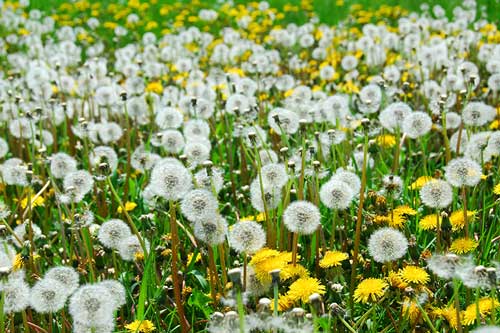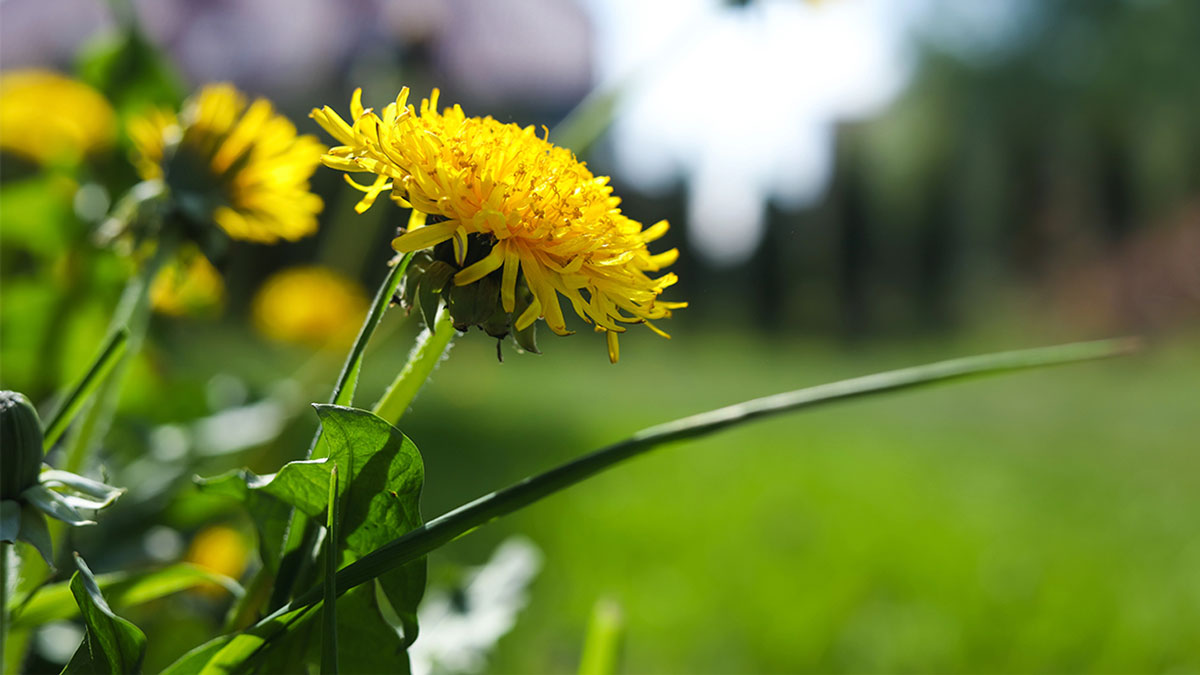Dandelions — for many, they evoke childhood memories of blowing fuzzy seeds into the wind. But for homeowners who care about a healthy, lush lawn, these yellow-flowered weeds are often less nostalgic and more of a seasonal headache.
Dandelions are hardy, fast-spreading perennial weeds that compete with turfgrass for water, nutrients, and sunlight. Left unchecked, they can quickly take over your yard, making proper identification and timely control essential. Here’s everything you need to know about spotting, removing, and preventing dandelions in your lawn.
Identifying Dandelions

Dandelions in two stages: bright yellow blooms and fluffy white seed heads, both ready to spread across lawns and landscapes.
The name “dandelion” comes from the French dent de lion, meaning “lion’s tooth,” a nod to the plant’s jagged, toothed leaves. Dandelions are easy to recognize at two stages:
- Bright yellow flowers bloom singly on hollow, leafless stems.
- White, fluffy seed heads develop when the flowers mature, ready to scatter seeds with the slightest breeze.
Dandelions grow low to the ground with a basal rosette of lobed leaves, and their deep taproots can reach up to three feet in length. These plants can thrive almost anywhere — from lawns and garden beds to cracks in sidewalks.
Dandelion Lookalikes
A few plants closely resemble dandelions:
- Cat’s Ear: Yellow flowers similar to dandelions, but with hairy leaves and branching stems.
- Sow Thistle: Resembles dandelions but grows multiple flowers per stalk and lacks hollow stems.
- Common Groundsel: Produces similar fluffy seed heads but is smaller and considered poisonous.
Accurately identifying true dandelions is critical before beginning any control efforts.
Why Dandelions Are a Problem
While dandelions have some redeeming qualities — their flowers are an important early-season food source for bees, and their greens are packed with vitamins — they can cause significant damage to your lawn:
- Water competition: Dandelions absorb moisture that your turfgrass needs to survive.
- Soil domination: Their dense rosettes choke out grass, reducing lawn strength and health.
- Seed production: A single dandelion can produce up to 15,000 seeds that germinate quickly in moist or compacted soil.
If left unmanaged, dandelions will spread aggressively, leading to sparse, weak lawns that are more prone to other weed invasions.
Why Dandelions Are Hard to Eliminate

Dandelions have deep, thick taproots that make them tough to eliminate — even small root fragments can regrow into new plants.
Dandelions are resilient because of their thick taproots, which can regenerate new plants from root pieces as small as one inch. Simply mowing or pulling the tops off won’t eliminate them — they must be fully uprooted or treated systemically.
Adding to the challenge, dandelion seeds travel easily by wind, allowing them to establish in new areas with little effort. Wet springs, sunny weather, and poor lawn health all create ideal conditions for these weeds to thrive.
How to Get Rid of Dandelions
1. Manual Removal
If you have only a few dandelions, manual removal is a good first step. Use a dandelion puller or digging tool to extract the entire taproot. The best time to dig is when the soil is moist, which makes the roots easier to remove.
Be sure to fill any holes afterward with soil and reseed the area to prevent other weeds from moving in.
2. Spot Treatments
For moderate infestations, spot treat individual plants using a targeted herbicide or natural alternative like horticultural vinegar, fatty acid soaps, or clove oil-based products. Always follow manufacturer instructions carefully and apply when temperatures are mild and rain is not forecasted.
Pro tip: Avoid using household vinegar — it’s often too weak to be effective on deep-rooted dandelions.
3. Broad Application Herbicide
When lawns are heavily overrun, a full-lawn herbicide treatment may be necessary. Fall (October–November) is the best time to apply selective broadleaf herbicides such as 2,4-D, dicamba, or MCPP. During fall, dandelions naturally send nutrients to their roots for winter, carrying the herbicide deep into the taproot and increasing its effectiveness.
Always apply herbicides responsibly, avoiding windy days and extremely hot weather. If possible, choose eco-friendly or natural formulations to minimize environmental impact.
Best Practices for Preventing Dandelions
Complete dandelion elimination can be difficult, but you can make your lawn less inviting to these stubborn weeds by following a few key practices:
- Mow high: Keep your lawn around 3 inches tall. Taller grass shades the soil, preventing dandelion seeds from germinating.
- Feed your lawn: Stick to a regular fertilization schedule to keep your turfgrass thick and healthy.
- Mulch clippings: Leave grass clippings on your lawn after mowing to act as a natural mulch, smothering new seeds.
- Improve soil health: Conduct a soil test and amend your soil as needed. Dandelions thrive in acidic, compacted soil. Adjusting pH and adding organic matter like compost can make your lawn less hospitable to weeds.
- Apply pre-emergent herbicides: In late winter or early spring, pre-emergents can prevent dandelion seeds from sprouting.
FAQs About Dandelions

Dandelions aren’t just weeds — their greens, flowers, and roots are edible and rich in nutrients like vitamins A, C, and K.
Are dandelions edible?
Yes! Dandelion greens, flowers, and roots are all edible and packed with nutrients like vitamins A, C, and K, as well as calcium and iron.
How fast do dandelions grow?
Dandelion seeds can germinate in as little as 7–21 days, especially in cool, moist soil.
Can I permanently get rid of dandelions?
Complete eradication is difficult, especially if your neighbors’ lawns also have dandelions. Regular lawn maintenance and quick removal of new weeds are your best defenses.
Do natural remedies work for dandelions?
Natural options like horticultural vinegar or boiling water can work on young dandelions, but deep-rooted plants may still require stronger herbicides or professional treatment.
Let Aspen Help You With Expert Dandelion Control
Keeping dandelions out of your lawn takes more than just a one-time treatment — it requires year-round attention. At Aspen Lawn & Pest Control, we offer proactive solutions to stop dandelions before they spread and protect your lawn through every season. From targeted weed control in the spring and summer to maintaining a thick, healthy lawn in the fall and winter, our team helps ensure your yard stays lush, weed-free, and vibrant.
Contact us today for a Free Estimate and take the first step toward a healthier, dandelion-free lawn this year!


Socials